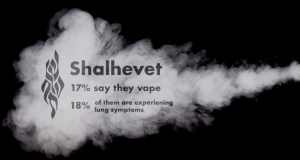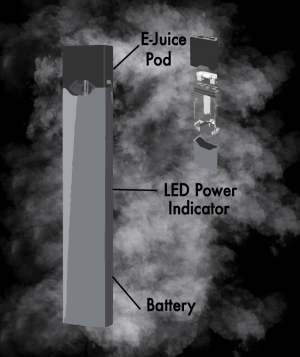LETHAL VAPOR: At least 12 deaths so far from mysterious vaping illness
Patients suffer hospitalizations, life-threatening lung injuries; 18 percent are teens
October 3, 2019
BP Graphics by Zev Kupferman
There are lots of reasons not to vape. For one thing, it’s against Shalhevet rules, as Principal Daniel Weslow announced to the community at an assembly in the fall of last year.
 Vaping can also cause addiction to nicotine — the most addictive part of tobacco — even though it contains no tobacco. That means once you start, it may be very hard to stop.
Vaping can also cause addiction to nicotine — the most addictive part of tobacco — even though it contains no tobacco. That means once you start, it may be very hard to stop.
And since 2016, vaping has also been illegal in the state of California for anyone under 21 years of age.
But suddenly, in the last three months, more than 805 people around the country have been hospitalized with a somewhat mysterious, life-threatening and vaping-related lung condition, which feels like a terrible case of pneumonia or another bacterial or viral infection but does not have any known cause such as asthma or the flu.
The federal Centers for Disease Control in Atlanta announced Sept. 27 that the number had grown from just 503 hospitalizations a month earlier. Some patients had been hospitalized for weeks at a time. All were regular users of e-cigarettes, and more who were vaping THC — the main ingredient in marijuana — than tobacco salts.
As scientists continue to investigate what is now being called “Vaping-Associated Lung Injury,” a Mayo Clinic study published Oct. 2 found that the damaged lungs resembled those of people who inhaled toxic fumes and suffered chemical burns.
The CDC said that of 771 cases with available data on sex and age, 38 percent were in people under 21, and 16 percent were under 18.
Twelve patients have died.
At Shalhevet, a poll conducted Sep. 16 showed that 17 percent of students had vaped during the last month — 11 of 64 students polled on paper forms distributed at breakfast.
Half said their parents knew and half said they didn’t. Half had started vaping more than a year ago.
Two of the 64 polled students said they vape every day, and both of them said they were experiencing lung symptoms. The poll was anonymous so they could not be interviewed for more details about their condition.
Ironically, electric cigarettes were originally intended to give cigarette smokers a safe alternative to tobacco by giving them nicotine without tar — the viscous and cancer-causing residue produced from burning tobacco.
According to the Center on Addiction, a non-profit organization based in New York: “Vaping is the act of inhaling and exhaling the aerosol, often referred to as vapor, which is produced by an e-cigarette or similar device.”
A battery heats a liquid, which contains nicotine, flavoring and other substances, and the heat turns the liquid into aerosol — tiny liquid particles suspended in a gas. The aerosol is inhaled into lungs.
E-cigarettes were originally introduced to the U.S. market in 2007. While there are many types, the most common is a “pod” vape, popularized by JUUL, currently the most recognized brand.
A pod vape resembles a flash drive, making it easy to hide and popular with students. The largest part of the device is a battery, which is attached to a pod containing the liquids that are heated into aerosols.
A single JUUL pod, which their website says is roughly 200 puffs, contains the same amount of nicotine as a whole pack of cigarettes.
Marijuana vaping is also very common among teenagers, with 13.1 percent of 12th graders nationally reporting having vaped marijuana in 2018, according to the Monitoring the Future survey.
 Marijuana vapes often come in a pen shape. The liquid commonly used is hash oil, a fatty oil extract from the marijuana plant which can contain up to 80 percent THC, the main psychoactive chemical in marijuana, according to a website of the state of Colorado.
Marijuana vapes often come in a pen shape. The liquid commonly used is hash oil, a fatty oil extract from the marijuana plant which can contain up to 80 percent THC, the main psychoactive chemical in marijuana, according to a website of the state of Colorado.
One benefit of marijuana vaping is that has no smell.
Answering an anonymous online questionnaire, a Shalhevet student who said they vaped THC wrote that that was why.
“I can get high without smelling like weed,” the student said.
Studies have shown that vaping is skyrocketing. The 2018 Monitoring the Future” survey found that 21 percent of high school students had vaped within the past month, almost doubling the 11 percent of the previous year. If that trend has continued in 2019, almost half of all teens are vaping now.
At Shalhevet, information about the danger of vaping has become far more widespread in the past month. That may be because of viral messages like an Instagram post by Simah Herman, a former student at YULA Girls High School.
On Aug. 29, Simah posted a series of pictures of herself in a hospital bed hooked up to a breathing apparatus, each one holding up a paper with a message written in Sharpie. The post has nearly 1 million likes.
In the images, Simah is holding up papers with messages written in Sharpie.
“I want to start a no vaping campaign,” says one.
“The dangers of vaping are real and this can happen to you,” she writes in the caption of her post. “Please don’t let it. It’s not easy to quit, nicotine is a very addictive chemical but the more you vape the more likely you are to end up where I did.”
She wrote that during her time vaping, she had developed symptoms including nausea and blurred vision. But she did not suspect that it was because she vaped.
“Please tell your family and friends the dangers of vaping because no one realizes until they’re put in a situation so serious,” Simah wrote.
Simah wrote that she was put into a drug-induced coma while in the hospital, and was sharing her story so other people don’t go through the same experiences.
“Don’t let vaping win. Take back your life and quit smoking. it’s just not worth it.”
According to senior Gabby Lasry, one of Simah’s friends, she is out of the hospital now and “doing much better.”
The Boiling Point contacted Simah and she replied that she was “taking a break” from publicity and didn’t want to be interviewed. But she said she hoped to speak to the whole Shalhevet student body at some point about what happened to her. She’s hoping the publicity will cause people to quit.
Of the 11 Shalhevet students polled who said they vape, four said they had tried to quit. One said he or she had quit successfully.
“I stopped because I was scared of the dangers of vaping,” that student said.
According to the NewYork Times, warning signs for Vaping-Associated Lung Injury include chest pain, nausea, coughing, fatigue, and shortness of breath. These can be symptoms of other illnesses as well, including asthma, pertussis, pneumonia and the flu.
But if you experience those symptoms, you should stop vaping immediately and see your doctor, health officials said.
Dr. Julie Higashi, Tuberculosis Controller at Los Angeles County Department of Public Health, said that not enough research has been done to determine a threshold of symptoms that should send someone who vapes to a doctor.
“The thing about vaping is that we have no idea how it may affect the body,” said Dr. Higashi, who is the mother of senior Kiku Shaw. “I don’t know that there’s a threshold. I don’t know that you could think you’re going to be okay up to a certain point. I don’t think we know enough.
“And that’s what happens when clinical syndromes develop and they’re new,” she added. “It takes us a while in the medical community to understand what to look out for.
“If you’re feeling ill and you’re vaping at all, don’t be reluctant to reach out to your healthcare provider.”
She also said you should stop vaping right away.
Dr. Higashi said many of the cases resemble something called “lipoid pneumonia,” where fat particles enter the lungs and cause an inflammatory reaction which can ultimately lead to lung failure or permanent damage.
This is different than smoking tobacco, a substance filled with carcinogens, which causes lung cancer by damaging the cells which line the lungs, according to the Mayo Clinic.
While no one knows for sure, Dr. Higashi said that there could be something dangerous in the aerosol unrelated to the nicotine or THC that is being inhaled.
“Some of these illnesses have occurred when people are vaping nothing but the flavor,” said Dr. Higashi referring to non-nicotine vaporizers. “And so the actual vehicle may be part of what’s impacting health.”
She said all of the cases involve an inflammation in the lungs.
“What it is is an inflammatory response because there is a substance in the lungs and the body is fighting that off,” said Dr. Higashi.
Researchers in the Mayo Clinic study found lung damage resembling what was caused by chemical weapons. Dr. Brandon T. Larsen, a surgical pathologist at the Mayo Clinic in Scottsdale, Ariz., told the New York Times the patients’ lungs looked like those of victims of mustard gas — the devastating chemical weapon used in World War I and then banned by international treaty. The study examined biopsies from 17 patients, including a 25-year-old and a 31-year old who had died.
The FDA warns especially about vaping THC, because the correlation between THC and the new illness appears especially strong. But some of the severely ill vaped only nicotine.
Whether people are sick or not, the CDC recommends they give up any type of vaping until further information about the illness is found.
“People should not vape,” said Dr. Higashi.
Now, with hundreds of young people severely sick, vaping has evolved from an evolving public phenomenon into a public health crisis.
On Sept. 20, Walmart announced it would stop selling e-cigarettes at its stores across the United States. Other stores have recently done the same, including Costco and Rite Aid. In addition, CNN and CBS said they will no longer air advertisements for e-cigarette companies.
President Trump recently announced a plan to ban flavored e-cigarettes. He tweeted “While I like the Vaping alternative to Cigarettes, we need to make sure this alternative is SAFE for ALL! Let’s get counterfeits off the market, and keep young children from Vaping!”
In California, vaping is considered a kind of smoking and subject to the smoking minimum-age laws, banning sales to those under 21.
Schools around the country are also getting involved. According to the New York Times, a school in Alabama removed the bathroom stall doors in an attempt to prevent students vaping while hiding out. In Colorado, a school forfeited a volleyball game after finding out students were vaping.
In a Pennsylvania school, students caught with vaping devices face a three-day suspension and a $50 fee, the Times said.
Mr. Weslow said that Shalhevet currently does not plan to punish students caught vaping on campus any more than the handbook mandates for any substance use — which is a possible expulsion. But he also said the administration had been meeting since the beginning of the year about how to best address the issue.
So far, he said, they’re planning to have the guidance department as well as professionals talk to students about the science behind the danger of vaping, and also how to resist social pressure to vaping.
“The focus right now is meaningful programming throughout the year,” said Mr. Weslow.
The thought of having a special program to address the health risks of vaping would not have crossed the mind of anyone just last June. School rules were already in place and had been publicized. Vaping seemed like something that could get you addicted to nicotine but more safely than smoking tobacco, or could get you high without getting caught.
Just four months later, the death total is at 12 and rising; the Mayo Clinic study put it at 16. Public health professionals still do not know what exactly in the vapor is causing the crisis.
But they know that it can be lethal.
This story won First Prize, CSPA 2020 Gold Circle Awards: Computer–generated Art/Illustration; First Prize, CSPA 2019 Digital Gold Circle Awards: Computer-generated Illustration; and Honorable Mention, American Jewish Press Association’s 2020 Simon J Rockower Award, Chaim Sheba Medical Center Award for Excellence in Writing about Health Care, Newspapers with circulation 15,000 and under.


